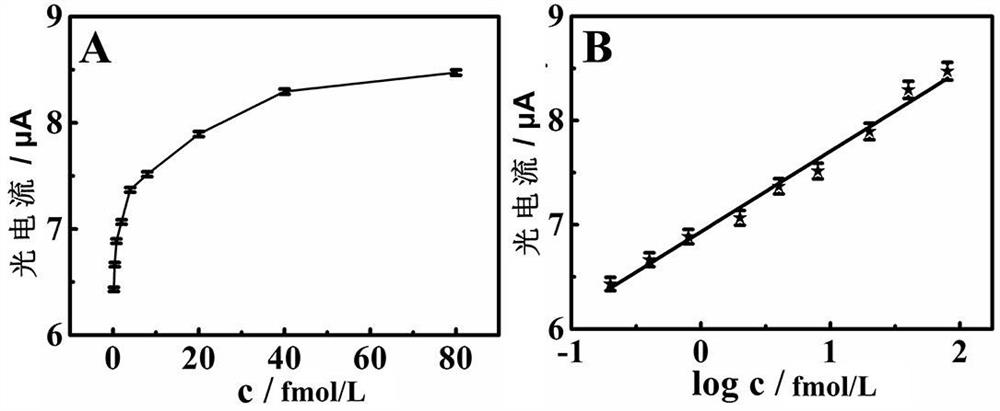Non-diagnostic cycle signal amplification photoelectrochemical detection method for syncytial virus RNA
A circulating signal and syncytial virus technology, applied in the fields of marine monitoring, medicine, and analytical chemistry, can solve the problems of incomplete effectiveness and achieve low detection limit, excellent detection and analysis performance, and wide detection range.
- Summary
- Abstract
- Description
- Claims
- Application Information
AI Technical Summary
Problems solved by technology
Method used
Image
Examples
example 1
[0044] Example 1: Analytical Properties
[0045] Powdered tungsten diselenide (WSe 2 ) were purchased from Bailingwei Technology Co., Ltd. (Beijing, China). MAX (Ti 3 AlC 2 ) was obtained from Scientific Compass Feynman Nano. (Zhejiang, China). Chloroauric acid (HAuCl 4 •4H 2 O) Ordered from Shanghai Reagent Co., Ltd. (Shanghai, China). 6-Mercaptohexanol (MCH) was ordered from Sangon Bioengineering Shanghai Co., Ltd. (Shanghai, China). 4-Aminophenyl phosphate monosodium (4-APP) was obtained from Shanghai Huicheng Biotechnology Co., Ltd. (Shanghai, China). Streptavidin-conjugated alkaline phosphatase (SA-ALP), 4-aminophenol (4-AP), N,N-dimethylformamide (DMF), squaraine (SQA), and tris(2- Carboxyethyl)phosphine (TCEP) and all other reagents were obtained from Aladdin (Shanghai, China). By adding 0.2 moles per liter of NaH 2 PO 4 and 0.2 moles per liter NaHPO 4 Phosphate buffer solutions were prepared by mixing stock solutions containing 0.1 mol per liter of potassi...
example 2
[0049] Example 2: Repeatability, Storage Stability, Selectivity
[0050] When the syncytial virus RNA concentration was 80.0 fmol / L, the repeatability of the method was investigated, such as figure 2 A shown.
[0051] The long-term storage stability of the modified electrodes was investigated by measuring syncytial virus RNA at a concentration of 80.0 fmol / L every six days. After 30 days of storage, the modified electrodes were monitored for five consecutive cycles, and the photocurrent response showed no significant change. Therefore, the modified electrode exhibits excellent stability, such as figure 2 shown in B.
[0052] The performance of the PEC method was investigated by testing the signal response of interfering substances (influenza A virus RNA (Flu-A), adenovirus RNA (ADV), human rhinovirus RNA (RV), and human hyperpneumovirus RNA (HMPV)). Optional. When 1.0 fmol / L syncytial virus RNA was used as the detection sample, a significantly improved photocurrent resp...
example 3
[0053] Example 3: Morphological Characterization of Materials
[0054] TEM characterizes WSe 2 and morphologies of AuNPs. like image 3 shown, WSe 2 presents an irregular hexagonal shape, and after peeling, WSe 2become thinner. AuNPs have a good uniform spherical shape with a size range of 6–10 nm. Ti 3 AlC 2 Presents a blocky morphology with a smooth surface. Ti 3 AlC 2 side as image 3 C, but the layered structure is not obvious. After etching MAX with lithium fluoride and hydrochloric acid, the bulk Ti 3 AlC 2 It is transformed into a typical organ-like structure, and the Al layer is peeled off to obtain an organ-like morphology in the figure, which indicates that Ti has been successfully prepared. 3 C 2 .
PUM
 Login to View More
Login to View More Abstract
Description
Claims
Application Information
 Login to View More
Login to View More - R&D
- Intellectual Property
- Life Sciences
- Materials
- Tech Scout
- Unparalleled Data Quality
- Higher Quality Content
- 60% Fewer Hallucinations
Browse by: Latest US Patents, China's latest patents, Technical Efficacy Thesaurus, Application Domain, Technology Topic, Popular Technical Reports.
© 2025 PatSnap. All rights reserved.Legal|Privacy policy|Modern Slavery Act Transparency Statement|Sitemap|About US| Contact US: help@patsnap.com



